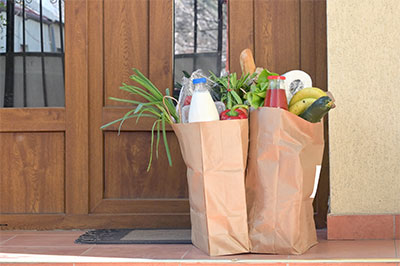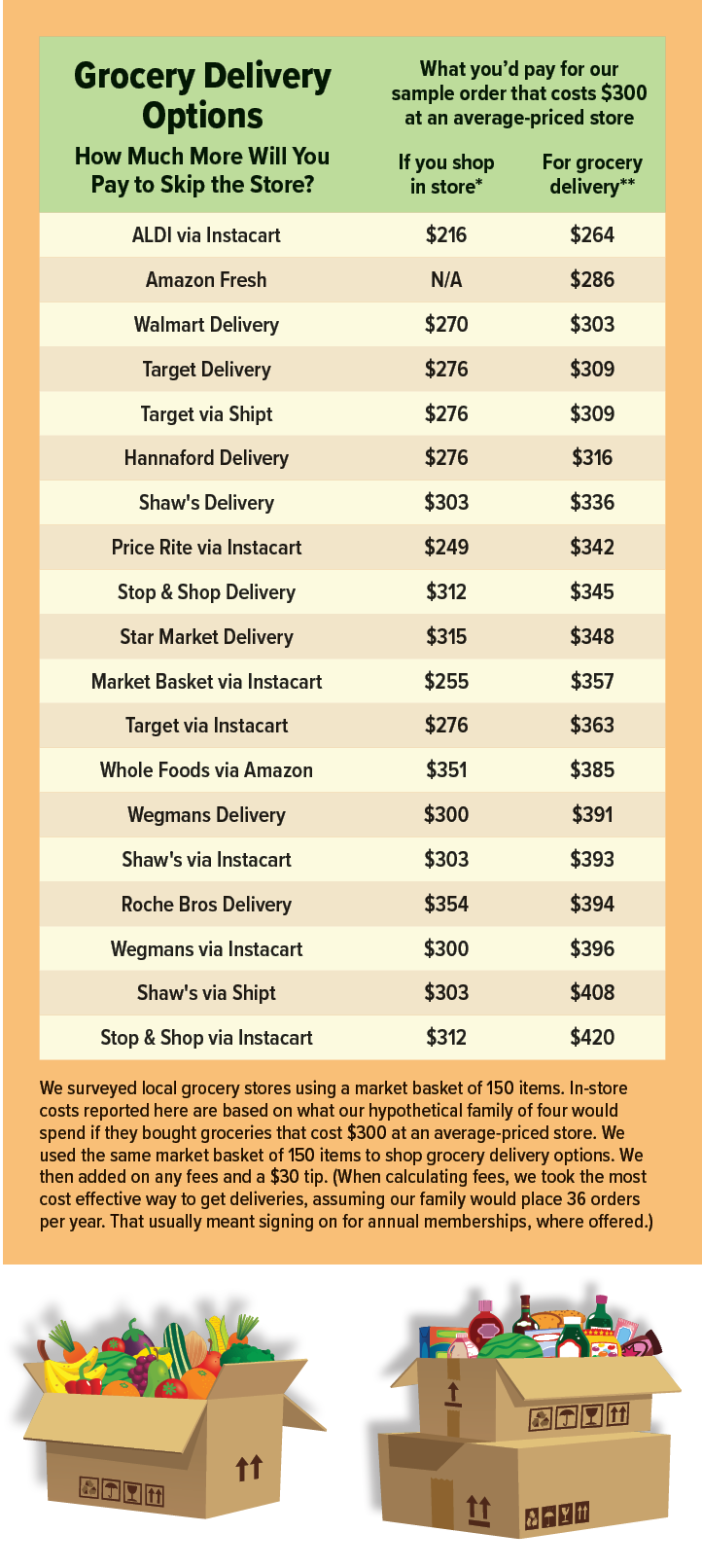Grocery Delivery: Pros, Cons, and Costs of Having Someone Else Do Your Shopping
Last updated November 2025

While supermarket shoppers aren’t avoiding the aisles like in 2020, the pandemic lockdowns did hook a new pool of consumers on grocery delivery services. A little more than half of American families bought groceries online during 2024, and 28 percent of U.S. adults grocery shop online at least once a month, according to an analysis by Capital One. Although the industry is no longer seeing triple-digit earnings growth, the number of households ordering grocery deliveries continues to increase by eight or nine percent each year.
The big benefit of having your avocados, Doritos, and whatnot delivered is that it’s a time saver. These services also provide critical help to those who can’t get to local markets due to physical impairments or a lack of transportation.
In this area there are many ways to get groceries dispatched to your door. Most large chains run their own delivery operations. You can also place orders via Instacart or Shipt, which are third-party services that hire gig workers to assemble and transport groceries. At many smaller chains and independent stores, the third-party apps are your only options.
Except for Amazon Fresh, which runs a centralized distribution system, most grocery stores pay someone to walk up and down aisles to assemble your stuff and then transport it to you. This system merely transfers shopping labor from you to others—and someone pays for that. At some stores, extra costs for delivery are very small (only a few dollars per order), but at others we found that many consumers are paying large premiums to skip the store.
Big Differences in Delivery Costs
The table below reports how grocery delivery services we evaluated compare for price. We shopped each option using our market basket of 150 items (the same list we used to compare in-store prices at conventional supermarkets). We then compared the prices we collected from delivery services to those offered in-store at area brick-and-mortar stores we surveyed. The table reports how much our illustrative family of four would spend with each of the grocery delivery services for an order that would cost $300 at an average-priced grocery store.
All the delivery services we checked have annual fees, per-delivery fees, and/or service fees. Some also mark up prices offered in stores. How much more you’ll pay for delivery depends heavily on where you shop and which service you use.
Several options drive up your costs with high delivery fees—sometimes $10 or more per order. With most, you can pay a membership fee to get unlimited free deliveries or pay lower per-order fees; if you order often, you’ll save by joining. (In our cost comparisons, we assumed our customer would place 36 orders per year and would choose the least expensive option for delivery fees; for services that offer annual memberships, we divided their yearly fee by 36 and added it to the order total.)
We also added a $30 tip to our hypothetical order for each delivery option. If this is less than you’d tip, then adjust our estimates accordingly, but please do tip; order fillers and drivers are paid little and rely on gratuities. Some services accommodate tipping better than others; with a few, there’s no way to do it while ordering, so you have to tip with cash.
Aside from the $30 tip we added, at some stores it wasn’t much more expensive to have your groceries delivered versus shopping for them in person. Not including gratuity, it costs only a few dollars extra per order to get deliveries from the dedicated services of BJ’s, Shaw’s, Star Market, Stop & Shop, Target, Walmart, and Whole Foods.
But with some delivery services, markups and fees added $40 or more to our totals. Our biggest cost increases usually were due to Instacart charging steep markups on many stores’ prices. For our sample order, using Instacart to order deliveries from Stop & Shop cost us $78 more than what we’d pay in-store, plus tip; placing our order at Shaw’s via Shipt cost us $75 extra, plus tip; and we’d pay $72 more, plus tip, to have groceries delivered from Market Basket via Instacart.
The total cost of our delivery order, including groceries, fees, and tip, ranged from a low of $264 for ALDI via Instacart to a high of $420 when ordering from Stop & Shop via Instacart.
Instacart and Shipt are listed multiple times in our price comparisons because they let customers choose among many different chains where they will send their shopper-drivers to find items you ordered, check out, and bring them to you. So, with Instacart you could make one order for Market Basket and another for Costco (each trip counts as a separate order). When you order via Instacart or Shipt, sometimes store personnel do the shopping and then the third-party service delivers it. Other stores simply allow Instacart’s and Shipt’s workers to shop for clients.
With most delivery options you can sign on for an annual membership (typically $99/year) and get unlimited free deliveries or pay reduced delivery fees. If you know you’ll place more than 10 orders a year, it’s usually a better deal to pay the membership fee, rather than per-order fees. Instacart and some supermarkets also charge per-order service fees (these aren’t tips—the fees go to the companies).
To get delivery orders from Amazon Fresh or Whole Foods, you need a Prime membership ($14.99/month or $139/year), but there are no additional per-order fees.
BJ’s and Costco also require membership to place delivery orders.

Grocery Delivery Benefits and Tradeoffs
Most consumers who use grocery delivery services do so to save time. But many others still prefer to do their own grocery shopping.
Ordering online requires more foresight than popping into a store and demands more planning than wandering aisles and throwing what looks good into a cart. And while with most delivery services you don’t have to be home when your order arrives, you’ll still want to schedule your orders to show up at a convenient time so your stuff doesn’t melt, spoil, or disappear.
Building lists of products you often buy makes the online shopping part of the process simpler—just pull up your list and click the things you need. But list-building is, at least at first, tedious. If you’re a freewheeling grocery store customer who doesn’t have it in you to make even a sketchy list, delivery services probably aren’t for you.
Stores’ inventory technology has drastically improved in the last few years, but on many sites searching for stuff remains incredibly frustrating. For example, looking for “Brussels Sprouts” in some stores yielded no results; we also got zero hits if we searched for “Gala Apples.” But punch in the improper “Brussel Sprouts” or just “Apples,” bingo!
Our researchers were also annoyed by Instacart and others that made them scroll through sponsored items, featured recipes, and “what others bought” before they could select the things they actually wanted.
At most sites, item descriptions are too vague. Were we buying a pound of jalapeños? A single pepper? A big bag of them? Often there was nothing to indicate what we’d get.
Worst of all, we were often frustrated by the slow speeds at many ordering websites. In some cases, it would have been faster to run to the store than to wait for pages to load.
On the other hand, shopping online drastically cuts back on impulse buys. And once you’re organized, delivery services can save time.
Some stores offer online ordering with at-store pickup. You still have to do the planning and list-making but you can check the quality of produce and meat before leaving the store. We didn’t price out these types of arrangements—we don’t have time to do everything—but several Checkbook staffers love this hybrid option.
The biggest downside? You must trust that delivery service personnel will select the unbruised bananas, nonsquishy grapes, and good-looking meats, and make the right call on substitutions when your choices aren’t available. The biggest complaints we get from consumers about grocery deliveries relate to receiving lousy produce and missing items.
With most delivery services, you tell it whether to pick a substitute or bring your order without that item; some even let you leave your shopper a note for each item. But delivery customers often report that orders arrive with missing items. Using a delivery service is no timesaver if you have to trek to a store anyway.


